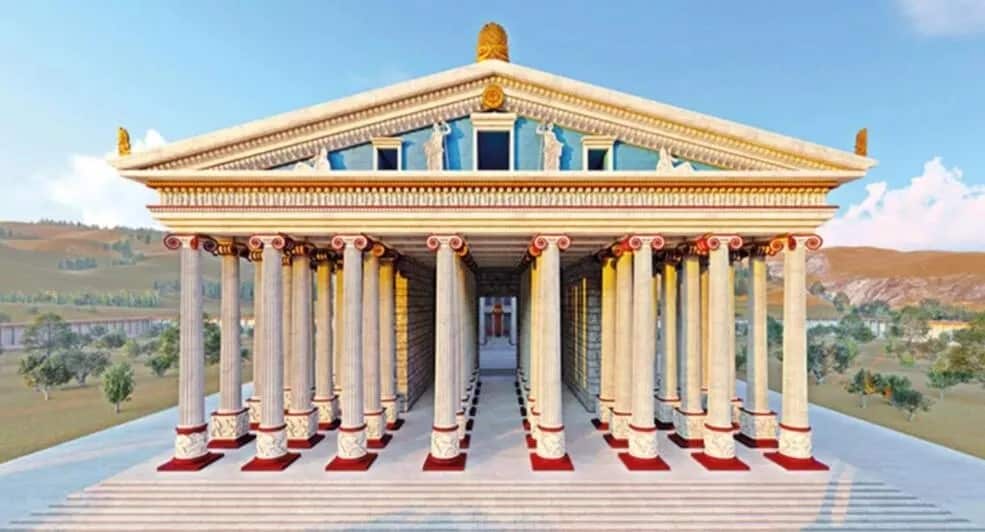The Temple of Artemis in Ephesus, one of the seven wonders of the world and whose ruins were looted after being destroyed by the Goths in 263, has been revived in the digital world to give people an insight into what the Ancient Greek world would have looked like.
Professor Ahmet Denker, who worked for 12 years in museums, especially the British Museum, where the stolen pieces of the Temple of Artemis are kept, revealed how the temple looked when it was built in a digital environment, according to Turkish outlet Hurriyet.
During these 12 years in the museums, Denker, who is a lecturer at Bilgi University’s Electrical and Electronics Engineering Department, worked in the British Museum, the Ephesos Museum in Vienna, the Vatican Museum, the New York Metropolitan Museum, the Kapitoline Museum in Italy and the Ashmolean Museum in Oxford and found the pieces of Artemis.
This is how Denker’s journey that gave life to Artemis began: He spent his childhood in İzmir. He had learned the name of the Temple of Artemis in a story written by the Fisherman of Halicarnassus when he was still in middle school.
In his own words, going to Ephesus on a school trip was a complete disappointment for him. The temple was not in its place. When he went to England to do his doctorate in the 1980s, one of the first places he visited was the British Museum.
Visiting the Greek collection of the museum, he saw two capitals of Artemis, carved from veinless white marble, up to 3 meters in width. There, he decided to do a study about Artemis. While Denker was continuing his studies in Turkey, computer technologies were developing.
Drawings could be transferred to the computer in 3D, and buildings could be constructed on the screens. Late Ekrem Akurgal, the doyen of Turkish archaeology, wrote in a book that it was possible to resurrect the temple, based on the pieces in the British Museum.
This was the beginning for Denker. With special permission from the British Museum, he spent three summers in the warehouses of the Department of Greek and Roman Antiquities. He measured and drew the pieces of Artemis one by one.
“There was not enough information about what Artemis looked like. Only two small fragments survived from the pediment of the temple, from which it was impossible to find out what it looked like. The coins from that period helped us. The frontal view of the temple was engraved on the front of the coins. The Temple of Artemis in Sadis, the Temple of Apollo in Didim and the Temple of Artemis in Manisa, built by architects under the influence of Artemis, also completed the other missing parts,” Denker told daily Hürriyet.
The Temple of Artemis study, completed after 12 years of effort by Denker and his students, has been collected in the book titled “Klasik Çağın Kaybolan Harikası Artemis Tapınağı: Tarihçesi, Mimarisi ve Dijital Rekonstrüksiyonu” (The Temple of Artemis, the Lost Wonder of the Classical Age: Its History, Architecture and Digital Reconstruction), to be published by Istanbul Bilgi University. The book will be on the shelves soon.
The biggest blow to Denker’s Artemis work was when Turkish-backed ISIS terrorists destroyed the Ancient City of Palmyra. Denker and his students set aside their studies of Artemis and turned to drawings of the city of Palmyra, known as the “Bride of the Desert.”
Studies on the city of Palmyra were awarded the best paper award at a conference in Valencia, Spain. This caused Denker to accelerate his work on Artemis even more.
The ancient Greek city of Ephesus, now located within the borders of the Selçuk district of İzmir, was started to be built in 3000 B.C.
Ancient Greeks built the Temple of Artemis, one of the seven wonders of the world, in this city. However, the Temple of Artemis, which was famous in the ancient world, was destroyed in 263 by the attacks of the Goths.
Its ruin was systematically looted and over time buried under about 6 metres of alluvial mud. This mysterious temple, told by ancient historians, was discovered by the Englishman John T. Wood, who came to İzmir in 1863 as a railway engineer.
Wood pursued Artemis based on the writings of ancient historians. After many excavations, he finally found its traces. He unearthed the columns, statues and other fragments he found and took them to London in 1873. Some of the pieces were also taken from London to other European cities.
The Temple of Artemis, believed to be protected by the Amazons, was thus completely destroyed from the Anatolian geography.
READ MORE: Underwater archaeologists discover ancient Greek shipwreck in sunken city.

